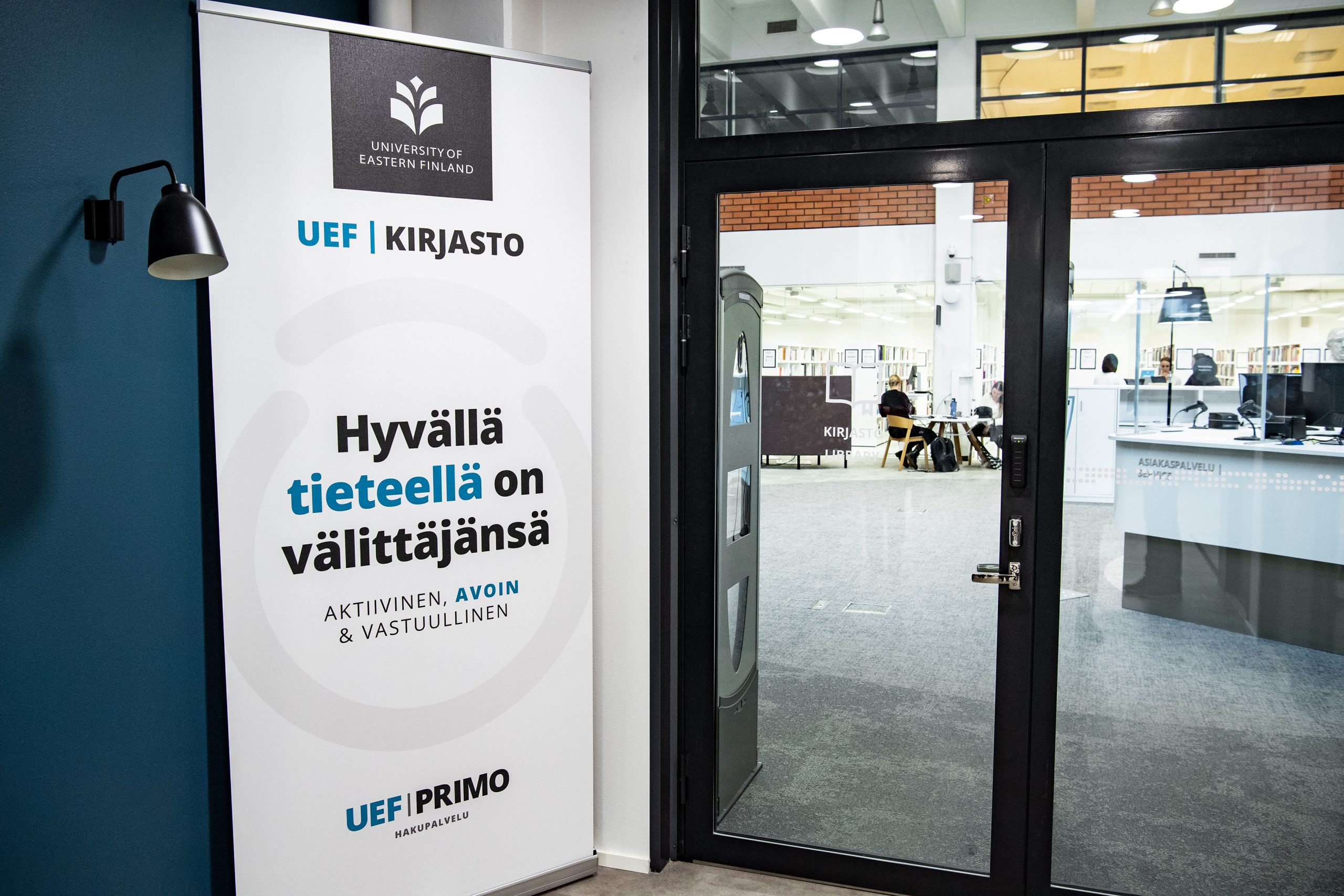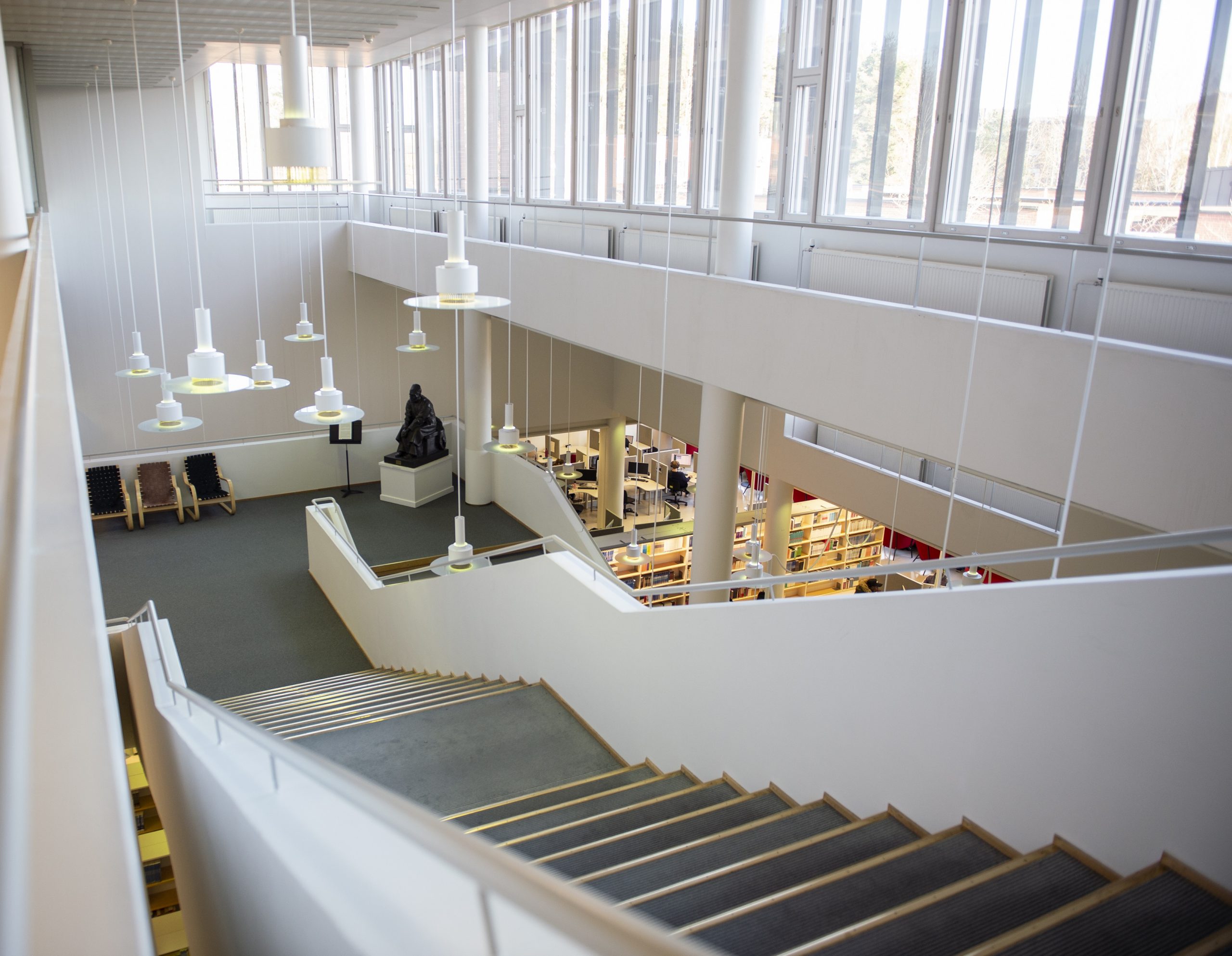Paluu arkeen – Itä-Suomen yliopiston kirjaston vuosikertomus 2022 | Back to Normal – The University of Eastern Finland Library’s Annual Report 2022
(Please, scroll down to read in English.)
Vuosi 2022 muistetaan varmasti pitkään koronatoimien päättymisestä. Yliopistollekin pääsi taas vapaasti. Pohdimme kirjastossa alkuvuodesta, mahtavatko asiakkaat löytää takaisin tiloihimme. Iloksemme saatoimme todeta vastauksen positiiviseksi. Esimerkiksi syyslukukauden alku oli meille yhtä juhlaa, kun saimme tuta uusien opiskelijoiden hämmennyksen ja riemun opiskelun alkamisesta. Nuorten into tarttuu meihinkin, työelämässä kiinni oleviin kirjastolaisiin.
Useimmat aineistojamme käyttävistä asiakkaistamme tekevät työtään etänä, joten kirjaston palveluidenkin pitää olla saavutettavissa verkossa. Sähköisten aineistojen käyttö kasvaa koko ajan. Tukea siihen tarvitaan kuitenkin jatkuvasti. Siksi laadimme uuden tiedonhakijan oppaan sekä otimme käyttöön kaksi uutta palvelujen tukijärjestelmää, Efecten ja chattibotin. Ensin mainittu on kirjaston sisäinen järjestelmä, jolla voimme entistä tehokkaammin kohdentaa sähköisesti tulevat kysymykset oikean asiantuntijan vastattavaksi. Chattibotti Uffe puolestaan auttaa vastaamalla yksinkertaisiin kysymyksiin, monimutkaisemmat ohjautuvat edelleen asiantuntijoillemme.

Opiskelu ja tutkimus eivät enää katso aikaa ja paikkaa, joten kirjaston tilojenkin on oltava käytettävissä vuorokauden ympäri joka päivä. Niinpä laajensimme tilojen ympärivuorokautista käyttöä myös pyhäpäiviin. Käyttö edellyttää kulkutunnisteen hankkimista sekä sitoutumista käyttösääntöjen noudattamiseen. Menneenä vuonna havaitsimme muutamia käyttöhäiriöitä. Onneksi keskusteluilla ja tiedottamisella tilanteet purkautuivat nopeasti. On kaikkien kannalta parasta, että asiakkaamme antavat toisilleen työrauhan.
Yliopiston kampuskehityshanke käynnistyi viime vuonna. Opiskelun ja tutkimuksen teon muutokset edellyttävät uutta ajattelua myös tilojen käyttöön. Kirjastolle tämä on mahdollisuus. Esimerkiksi painettujen aineistojen vähenemisen myötä kokoelmille varattuja tiloja voidaan muuntaa asiakaskäyttöön. Kirjasto on myös luonteva paikka yliopistolaisten ja kaupunkilaisten yhteisiin tilaisuuksiin. Tämän suuntaisia tilankäytön muutoksia on jo ideoitu, toivottavasti ne tulevaisuudessa myös toteutuvat.
Opetuksen muutokset
Korona-aika joudutti kovasti yliopiston opetuksen monimuotoistumista. Pakkoetäopetus on koronan väistymisen myötä takana, hybridiopetus on tullut tilalle. Kansallinen Digivisio 2030 -hanke lisää opiskelijoiden mahdollisuuksia suorittaa etäkursseja eri yliopistoista. Tämä kaikki edellyttää paljon myös oppimateriaaleilta. Pelkkä painettu aineisto ei riitä, etäopetus ja korkeakoulujen välinen opetus kaipaavat kovasti sähköisiä aineistoja. Kirjastolle tämä on uhka ja mahdollisuus. Sähköiset kurssikirjat ovat jo lyöneet läpi, mutta ne ovat kalliita hankkia. Avoimet oppimateriaalit ovat hyvä ja joustava vaihtoehto, mutta niiden käyttö edellyttää vielä paljon pohtimista ja käytännön toimia ennen kuin ne saadaan laajalti käyttöön.
Kirjasto on saanut ottaa tärkeän askeleen opetuksen suunnittelussa, kun sen edustajat ovat päässeet mukaan tiedekuntien koulutuksen kehittämisen toimikuntiin (KOTO). Näin kirjasto saa tarpeellista tietoa opetussuunnitelmatyöstä ja voi olla mukana tarjoamassa omaa opetustaan mukaan kurssitarjottimiin. Erilaiset opintojaksomme ovat olleet kovin suosittuja ja niitä kaivataan lisää. Erityisesti tiedonhaku, tiedon luotettavuuden arviointi, saalistajajulkaisujen tunnistaminen sekä aineistonhallintasuunnitelman teko olivat aiheita, joista meiltä kaivattiin opastusta opintojen eri vaiheisiin. Kurssitarjontamme onkin laajenemassa edelleen.
Vuonna 2021 päättyneen datatukihankkeen palvelut saatiin vakinaistettua osaksi kirjaston toimintaa vuoden 2022 alussa. Näille palveluille onkin laaja tarve tutkimuksen digitalisoitumisen myötä. Tutkijoiden on saatava tukea datanhallintaan työnsä kaikissa vaiheissa aineistonhallintasuunnitelman laatimisesta datan elinkaaren päättymiseen asti. Kirjastolla on merkittävä rooli tämän kokonaisuuden hahmottamisessa sekä palvelutarjonnan koordinoinnissa. Kirjastossa on laadittu oma sivustonsa tutkimusdataan liittyville kysymyksille, ja se on jo osoittautunut tarpeelliseksi.
Avoin tiede
Kirjaston lokakuussa 2022 järjestämät valtakunnalliset Tiedejulkaisemisen päivät kokosivat korkeakoulujen väkeä pohtimaan avoimien aineistojen tulevaisuutta sekä haasteita. Alati kohoavien tieteellisten julkaisujen lisenssimaksujen rinnalle ovat tulleet korkeat julkaisujen avoimeksi saattamisen kustannukset. Sen lisäksi, että niistä on tullut kiinteä osa kustantajien lisenssimaksuja, yliopistossa maksettiin noin 400 000 euroa näitä niin sanottuja APC-maksuja. Kotimaisten tieteellisten lehtien avoimeksi saattaminen ei vieläkään edennyt, koska sopivaa kustannusmallia ei ole saatu aikaiseksi. Pohdinta jatkuu niiltäkin osin.
Yksi yliopistomme strategisista tavoitteista on olla avoimen tieteen edelläkävijä. Yliopistolle perustettu uusi avoimen tieteen työryhmä pohtii, mitä tämä tarkoittaa sekä tekee esityksiä avoimen tieteen linjaamiseksi sekä edistämiseksi. Sen agendalla ovat niin avoin julkaiseminen, avoin data kuin avoin oppiminenkin. Työryhmä pohtii, miten kansalliset linjaukset ja kansainväliset suositukset saadaan sovitettua toiminnaksi yliopistossamme. Se tekee esityksiä päättäville tahoille eli tutkimuksen johtoryhmälle sekä opetuksen ohjausneuvostolle. Työ on vasta alussa, mutta tahti on kiihtyvä.
Painetut aineistot
Vaikka lähes kaikki uutuushankinta suuntautuu sähköisiin aineistoihin, kirjaston laajat painetun aineiston kokoelmat ovat edelleen hyvin varteenotettava lähdemateriaali monille tutkimusaloille. Voidaankin puhua humanistisesta infrastruktuurista. Etenkin kirjaston vapaakappalekokoelma on vielä osin löytämätön voimavara, siksi sen markkinointiin panostettiin viime vuonna. Kokoelma käsittää lähes kaiken Suomessa painetun aineiston noin neljän vuosikymmenen ajalta. Vapaakappaleiden löytyvyys on parantunut, kun aineistoa on saatu näkyviin kirjaston Primo-hakupalveluun.
Toinen yllätyksiäkin tarjoava vapaakappaleiden osa-alue on Kansalliskirjaston keräämä sähköinen aineisto. Se on vapaasti käytettävissä kirjaston molemmilla kampuksilla olevilla työasemilla.
Kirjaston tehtävänä on pitää osaltaan huolta siitä, että yliopistolaiset menestyvät opinnoissaan, tutkimuksissaan ja muissa töissään. Nykyisin tämä tarkoittaa kirjastolle hyvin moninaisia tehtäviä. Työtehtävien vaativuus on kasvanut, mutta henkilökuntamme on vastannut haasteeseen laajentamalla osaamistaan. Uusissa rekrytoinneissa tohtorikoulutuksen saaneiden henkilöiden osuus on kasvanut. Tämä vahvistaa tutkijoille annettavien palvelujen tarjontaa entisestään. Kirjaston mahdollisuus tukea yliopiston menestystä on hyvissä käsissä.

The year 2022 will certainly be long remembered as the year when the corona measures came to an end, and the university too was once again freely available. At the beginning of the year, we at the library discussed whether customers would find their way back to our premises. We were pleased to confirm that the answer was positive. For example, the beginning of the autumn semester was a throughout celebration for us, as we got to know the confusion and joy of new students about to start their studies. Despite being firmly in working life ourselves, the enthusiasm of young people attached onto us librarians as well.
Most of the customers that use our materials work remotely, so the library services must also be accessible online. The use of electronic materials is growing continuously, and support for this use is also needed. This is why we created the new Guide to Information Retrieval and introduced two new service support systems, Efecte and a chatbot. The former is the library’s internal system, with which we can forward electronic queries efficiently to the right expert. The chatbot Uffe, on the other hand, helps by answering simple questions, although the more complex ones are still directed to our experts.
Studying and research are no longer tied to time and place, so the library facilities must also be available around the clock, every day. Thus, we extended the round-the-clock use of the facilities to public holidays as well. 24/7 use requires the acquisition of a personal access badge and commitment to comply with the terms of use. We noticed a few failures to comply in the past year. Fortunately, the situations quickly unravelled with discussion and proper informing. It is best for everyone that our customers grant each other a peaceful environment.
The university’s campus development project was launched last year. Changes in studying and research also require new ideas for the utilisation of facilities. We view this as an opportunity for the library. For example, with the decrease in printed materials, spaces previously reserved for collections can now be converted for customer use. The library is also a suitable environment for joint events between university students and personnel as well as other city residents. There has already been brainstorming regarding changes towards this direction, and these ideas will hopefully also be implemented in the future.
Changes in teaching
The coronavirus pandemic hastened the diversification of university teaching significantly. Compulsory remote education is behind us as the coronavirus has receded, and hybrid teaching has taken its place. The national Digivisio 2030 programme increases students’ opportunities to take online courses from different universities. All this requires much in terms of educational material. Printed material alone is not enough, as distance education and inter-university teaching are in dire need of electronic materials. For the library, this is both a threat and an opportunity. Electronic course books are already in wide use, but they are expensive to acquire. While open educational resources are a good and flexible option, a great deal of consideration and practical action is needed before they can serve as the main solution.
The library has been able to take an important step in the planning of teaching by having its representatives included in the faculties’ committees for the development of education (KOTO). This way, the library receives necessary information about the curriculum work and can participate by offering its own teaching to the list of courses. Our various courses have been a success and there is a demand for more. We were sought guidance from particularly on the topics of information retrieval, evaluation of the reliability of information, identification of predatory publishing, and the creation of a data management plan. Our list of courses is ever-expanding.
The services that were a part of our data support project, which ended in 2021, were made a permanent part of the library’s operations at the beginning of 2022. The digitalisation of research ensures a widespread need for these services. Researchers must receive support for data management at all stages of their work, from the preparation of a data management plan to the end of the data life cycle. The library plays a significant role in shaping the overall picture and coordinating the range of services. The library has created a specific website for questions related to research data, and it has already seen much use.
Open science
The Research Publishing Days 2022, organised by the library in October, brought together people from higher education institutions to reflect on the future and challenges of open materials. In addition to the ever-increasing licensing fees for research publications, there are now also the high costs of making them open access. These have become an integral part of publishers’ license fees, and the university spent close to 400,000 euros on these so-called APC fees. The process of making domestic scientific journals open access has not yet proceeded, because a suitable cost model has not been found. The reflection continues on those points as well.
One of the strategic goals of our university is to be a forerunner in open science. The new open science working group of the university will consider the topic and further propose actions for the outlining and promotion of open science. Open access publishing, open data, and open learning are all included in its agenda. The working group will consider how national policies and international recommendations are to be adapted into actions at our university. It will make proposals to the decision-making bodies, i.e., the research management team and the Council for Teaching and Guidance. The work is just beginning, but the pace is accelerating.
Printed materials
While almost all new material acquisitions are electronic in nature, the library’s extensive collections of printed material remain noteworthy information resources for many fields of research. It is suitable to talk about humanistic infrastructure. The library’s legal deposit collection, in particular, remains underutilised as a resource, which is why we invested in its marketing last year. The collection comprises almost all material printed in Finland over a period of about four decades. The findability of legal deposit copies has improved as the material has been made available in the Library’s UEF Primo search service.
Another, sometimes surprising area of the legal deposit activity consists of the electronic materials collected by the National Library of Finland. The collection is freely available on the legal deposit workstations on both campuses of the library.
The library’s task is to ensure that university students as well as staff members succeed in their studies, research, and other work. Today, this comes with a wide range of tasks for the library. The requirements for the tasks’ completion have increased, but our staff has responded to the challenge by developing their expertise. In new recruitments, the number of applicants with doctoral training has increased. This will further improve the services provided to researchers. The library’s opportunity to support the success of the university is in good hands.
Ari Muhonen
Kirjaston johtaja | Library Director
***
Tilastot 2022 | Statistics 2022
Katso myös Tilastopalikat syöksykierteessä | See also Statistical blocks in a tailspin
Henkilökunta 2022 | Library staff 2022
Kirjaston henkilökunnan julkaisut 2022 | Library staff’s publications 2022